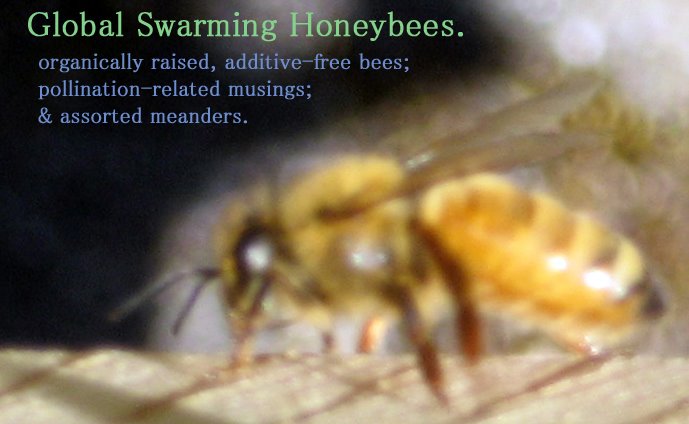The next day, there was good news and bad news.
The good news was that the U.S. postal service (for once) came through, with a surprisingly quick delivery of the hive.
The bad news was that getting the bees into the new hive was going to be a challenge, since the bees hadn't taken at all well to the temporary hive I'd fashioned out of an Office Max (OM) carton. By that morning, honeybees were merrily camped out on the front of the box in mass quantities, and had established several mini-civilizations in the gaps between the tarp and the box, and under the box, and along the concrete blocks on which the box was positioned. Lord only knows where the queen was in all that mess, or how I was going to get these disparate subpopulations into a single hive body.

Avoiding the inevitable moment of truth, I busied myself with preparing the new hive. I started by drilling three upper entrance holes in the front. (These entrances, along with the long narrow front entrance along the bottom of the hive, provide ventilation—an underrated issue in beekeeping—and give the bees a way to exit the hive for brief cleansing flights on warm winter days if snow has blocked the main entrance.)
Next, I began the pleasant task of applying dabs of melted beeswax to the guide bar on each top bar to provide an invitingly scented bee environment, and to encourage the bees to build their comb nice and straight along the top bar. (It's important to be able to remove each top bar to inspect the hives and carry out certain manipulations that promote the colony's well being over the course of the year. If the bees build their comb out of alignment with these bars, it becomes impossible to move the bars without destroying the comb and undoing lots of bee-labor, thus setting them back in their quest for overwintering capability and longterm survival.)

 Each of these top bars will go face down along the top of the hive, with the guides facing downward.
Each of these top bars will go face down along the top of the hive, with the guides facing downward.
Last but not least, I added a drop or two of lemongrass oil to the interior of the hive body. Apparently, this scent has been found to encourage honeybees to accept a new hive body, reducing the incidence of absconding. (Which, by the way, is quite different from Colony Collapse Disorder.)
I set the newly prepped hive outside in the sun, scrawled the name Rebel Rebel on the top cover, and waited until dusk. I'd been told that hiving at this time might further increase the chances the bees would accept the hive. I guess the thinking is, once they spend the night there, some level of attachment is created, especially if the home is a suitable one. And it probably goes without saying that a delicate procedure like hiving a swarm is best accomplished in fading light with minimal visibility. Not.
As dusk approached, I transferred one honeycomb and one comb of brood from Hive Orange into the new hive body to help the bees get started in there and provide some sustenance during their initial adjustment.
My able partner-in-swarmcatching-crime, Karen, had returned to the city, so I was on my own for this final phase in the swarm hiving process. I carried the new hive body to the bee yard and positioned it on the ground by the OM box and the legions of AWOL bees, who reminded me of nothing so much as a mob of deadheads trying to find their way through the parking lot after a particularly long-winded Grateful Dead concert.
I then brushed, shook, cajoled, directed, herded, ushered, scooped, hand-delivered, and, yes, dumped as many bees as possible into the new hive from their myriad locations under the tarp, between the holes in the concrete blocks, and within and without the OM box itself. I removed the OM box from its spot on the concrete blocks and lifted the new hive into position on the concrete blocks (Honeybees' GPS is finely tuned; the new hive had to be located just where the old hive was in order for the bees to orient to it properly.) I then closed the top, and went home for a much needed glass of beer.
As you can see, in spite of all their lollygagging here, there, and everywhere around the OM box, it seems the bees had (to some degree) accepted their temporary home by beginning to build comb on the lid—a sight I found inexplicably poignant. On the other hand, they'd begun doing the same thing under the tarp, so who knows what would have happened if they'd been left to their own devices there?
On the other hand, they'd begun doing the same thing under the tarp, so who knows what would have happened if they'd been left to their own devices there?
The next morning, I was pleasantly surprised to find the bees still in and around the hive. Many were clustered on the exterior, but by now I was getting used to that sort of behavior. Like the wonderfully enigmatically wild animals they are, the bees are going to do not what the books say they will do, nor what you expect them to do, but whatever they are moved to do. In this respect, they remind me very much of house cats.
Like the wonderfully enigmatically wild animals they are, the bees are going to do not what the books say they will do, nor what you expect them to do, but whatever they are moved to do. In this respect, they remind me very much of house cats.
For the time being, it seemed all was well with Rebel Rebel.
But the time being is, by definition, a painfully fleeting thing. The very next day, following a brief, respectful and clearly premature inspection of the hive, bees started pouring out the front entrance in waves and flying tumultuously skyward in a behavior disturbingly reminiscent of swarming. I couldn't blame them. They were understandably antsy and anxious and seeing my face yet again must surely have upset them. Learning Curve Lesson #799: Leave the bees alone, will ya???
I never did see whether the swarm-like throngs returned to Rebel Rebel, but after that incident, it seemed to me, there were fewer bees in the hive. Did some actually leave and, if so, had all-important queen departed with them? Did they all return once I was out of earshot and simply create the appearance of fewer bees because they were now getting organized with comb-building and nectar-gathering? As a new beekeeper, I am still in the earliest phases of learning to interpret my observations; I look forward to the day when I can better the connect the bee-dots.
Even with its (seemingly) smaller work force, the Rebel Rebel bees have been working hard at building comb, gathering nectar, and trying to build things up in there. But the ranks looked small and I wondered whether they'd be able to pull together the critical mass needed to build up their population and honey stores to a level where they could survive a long, cold Northern winter. To us, the season of snow and subzero temperatures seems far away, but for the bees, in a sense, it is just around the corner, with an unthinkable amount of work to be accomplished between now and then.
7.06.2007
Swarm Saga, Pt. 4 (Home at Last)
Subscribe to:
Post Comments (Atom)





No comments:
Post a Comment